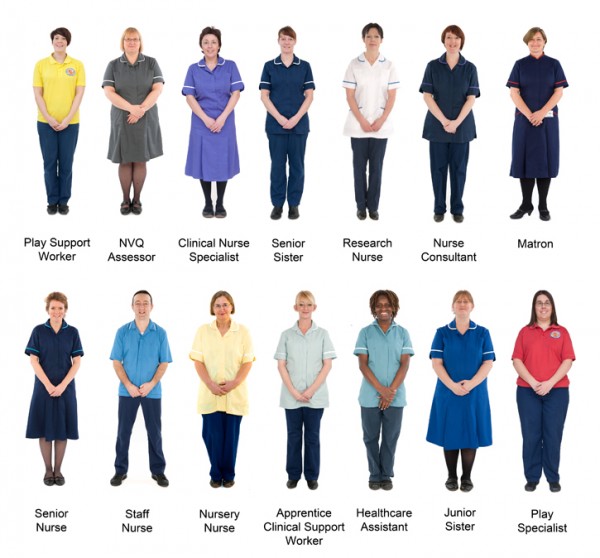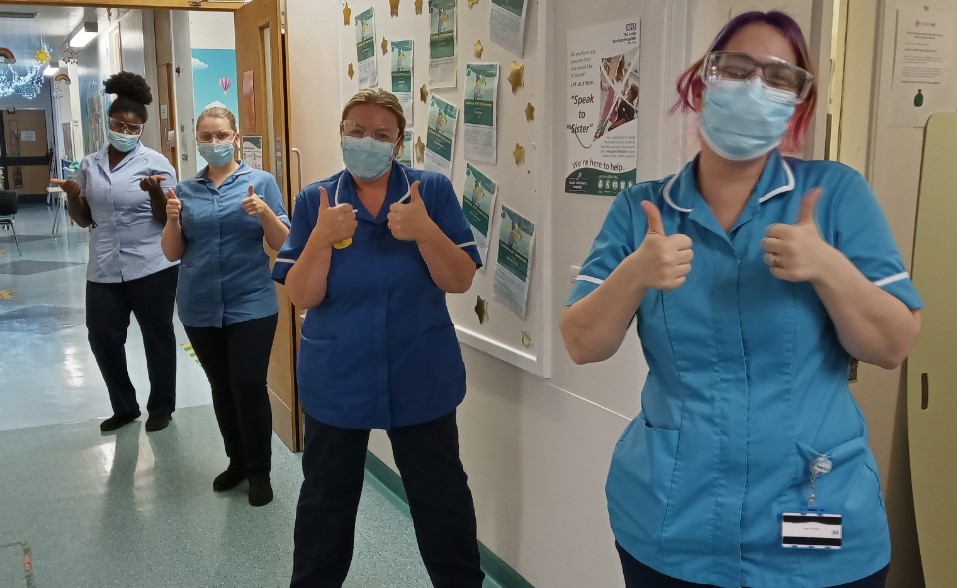When you arrive at the hospital you should make your way to the ward or department mentioned on your letter. If you don’t know where this is, the staff on reception will be able to help you and there are lots of helpful signs in the hospital. It’s a big hospital and even we get lost sometimes! If you do feel lost, ask any member of the team who will be happy to help point you in the right direction.
Who does what?
Most of staff wear different types of uniforms to help you understand the jobs that they do.

This diagram shows you what the different uniforms mean. If you’re not sure what someone’s job is – just ask them!
Since the start of the Coronavirus pandemic, many of our staff have been wearing special protective clothing called PPE so when you visit we might look a little different. Scrubs, masks, goggles, gloves and aprons are there to keep you, our family and us safe. We might look a bit strange but it’s still the same friendly team underneath!

There may also be times when some staff such as doctors and pharmacy staff are wearing normal clothes but everybody should be wearing a badge which tells you their name and what job they do. If someone comes to see you and doesn’t tell you their name, you can ask them what they are called.
When you arrive
When you arrive on the ward, you should let staff know that you have arrived. You may be shown to a bed or you might be asked to stay in the waiting room. You are more likely to stay in the waiting room if you are an outpatient but sometimes outpatients can have beds too. Some of our spaces like waiting rooms might look a little strange with extra plastic screens, stickers on the floor telling you where to stand and fewer chairs than there used to be. This is all to keep you, your families and us safe, during the Coronavirus pandemic.
When you are on the ward a nurse will usually weigh you and measure how tall you are. You may also have your temperature, blood pressure and heart rate measured but this will depend upon why you have come to hospital.
On the wards we do have some small one bed rooms but most of the beds on our wards are in larger rooms called ‘bays’ where there are usually between 4 and 6 beds for other children like you. Don’t worry if you want a bit of privacy. There are large curtains that can be pulled all of the way round each bed and these are usually drawn at night to help you sleep.
There will be a shared bathroom and toilet a short walk from your bed or the waiting room. If you don’t know where these are – just ask.
Each bed has a mobile table that can be wheeled around the bed, a TV and a phone. There will also be chairs for visitors to use and there is enough space by the side of each bed for a “foldaway” bed if a family member or carer is going to stay during the night with you. There is also a small cupboard for your belongings.
Our wards have small kitchens for grown-ups to make drinks and a fridge to keep food cool and fresh.
Eating and drinking
If you are staying overnight on the ward you will be able to choose from our menus. We have different selections every day and cater for different dietary requirements but if you are unable to eat the food on the menu or need something else, please talk to a member of staff.
You will have the choice of three meals a day:
- Breakfast is usually between 7 and 8am
- Lunch is between 12 and 1pm
- Dinner is about 5pm
You can read more about the food we provide in the hospital and the different type of menus available on our Patient Catering pages. These include menu options for special diets too.
There are also a number of places around the hospital where you can buy food.
Sometimes, even if you are not staying overnight but have had an operation, our staff like to see you eat or drink something before you will be allowed to go home. You will be offered something like toast or yoghurt to make sure that you don’t feel sick.
Digital Care Plans
We’re using new digital care plans in Leeds Children’s Hospital, which means you may see nurses using electronic devices when they talk to you about the care they are providing for your child.
What is a care plan?
We use care plans to write down how we’re going to care for your child, to record what we’ve done and what is happening next. Care plans help us to make sure your child is getting the care they need and makes sure their care is always safe. Recording this information electronically keeps all your child’s information in one place and makes it easy to share with other healthcare professionals when we need to.
What differences will you notice?
We used to write everything on paper. We’ll now record this information straight onto a computer or iPad and save it into your child’s electronic health record. This means that you may see nurses using electronic devices when they talk to you about the care they are providing for your child.
If you have any questions about our digital care plans, please speak directly to the nursing team caring for your child.